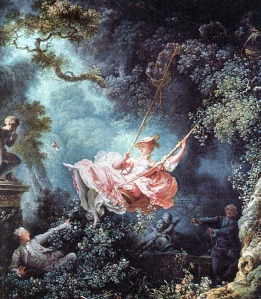When Thomas Kinkade died last week, I got a few emails and Facebook wall posts from former students. “I don’t know why, but I feel compelled to inform you about this.” I have had a long and complex relationship with the art of Thomas Kinkade, and his death brought him to the forefront of the greater consciousness (however briefly) once again.

This is an example of a Thomas Kinkade painting. There's no need to look at any other ones, they're all pretty much this.
Thomas Kinkade was a painter. He was a very well-known painter who produced thousands of paintings of quaint cottages in idyllic settings. Tomas Kinkade was a businessman. His galleries are in malls all across America. There are calendars, coffee mugs, prints of various qualities and price ranges, “original” paintings, and even a Kinkade-themed housing development in Northern California. For most in the art world, this places Kinkade firmly in the category of kitsch, with his reliance on mass reproductions of artworks and an easy appeal to a general populace.
When I was a graduate teaching assistant, instructing introductory-level studio classes, our first-day activity was to have the students fill out a form answering various questions about themselves. What kind of music did they like? What other art classes had they taken? And, of course, who was their favorite artists. When the TAs would get together after the first day, the conversation always turned to that last question. How many Van Goghs did you get? How many Dalís? Any late, great, unknown uncles? And the kicker—the question that would make us howl with laughter and wretch with disgust—how many Kinkades? We were snobs. We were art snobs. We were educated art snobs, and we were going to educate these uninitiated undergrads about what was good and what was bad art, and Thomas Kinkade was bad art.
There are several factors that go into dismissing Kinkade outright, and the kitsch argument is only one of them. His galleries, even if they were not franchised McDonald’s of paintings scattered across America and found next to the Dillard’s north wing of the mall, were vanity galleries. A vanity gallery is an art gallery that is owned and operated by the artist himself or herself. While academic art instruction sees itself as operating outside of the art market, the market’s peculiar institutions of legitimation are sacrosanct.
A gallery, in the operation of the art market, is a proprietorship of a connoisseur who gathers the work of a group of artists, legitimized by their inclusion in this stable (yes, this is how the collection of artists represented by a gallery are referred to). The connoisseur in the form of the art dealer then sells the work to connoisseurs in the form of the buyers. The connections and collecting history of the connoisseurs provide the provenance for the work, and the connection with that provenance further legitimizes the artist. They aren’t just making great work. It’s great because of who owns it and because of what else they own or have owned. A Jenny Saville isn’t just important because it’s a monumental painting, but because it was purchased by Charles Saatchi, and Saatchi also purchased work by Damien Hirst and Sam Taylor-Wood. Good connections in the primary market lead to even better connections in the secondary (auction) market, which lead to collection or donation to museums, which are the ultimate arbiters of what is important. What is important to museums is what ends up in art history text books, and it is what is taught to students as high art. This process, as convoluted as it is, begins in the person of the art dealer.
In a vanity gallery, the artist circumvents the dealer in order to get his or her work to the primary market. The work is sold, yes, but in the view of the institutions of legitimation, a necessary step in gaining legitimacy has been skipped. How can these primary consumers know what they like if they don’t have a connoisseur to tell them what is important? Thomas Kinkade made the vanity gallery into Wal-Mart, selling directly to consumers, legitimation be damned.
Aside from the inconsequential, saccharine-sweet subject matter of Kincade’s paintings, his primary sin in the eyes of the art world is this crucial skipped step. Other popular kitsch artists are simply ignored: Maxfield Parrish, Norman Rockwell, Anne Geddes, whoever took those photographs of children in adult clothes in the 1980s. For those who hate Kincade, he is more than ignored, he is reviled, and other “sins” are held up as support for this judgment that are allowed to pass with other artists—even artists widely recognized by the institutions as important.
Even as a student myself, I lambasted Kinkade’s use of employees in creating his works. “They aren’t even his!” I would argue, “He’s just the financier! He’s a businessman. Not an artist.” Many people share the expectation that the genius artist’s hands are the only hands that work toward creating the final object. The image of the artist’s studio in the heads of art students and the general public alike is one of a lone artist, toiling away at his massive projects.
Art is not made this way. For an artist to make money, very rarely is this even a possibility. In pre-Modern art eras, the sole-genius-production ideal was not as closely held. Renaissance artists like da Vinci and Michelangelo were part of a guild system, where apprentices would do basic work like backgrounds in paintings or rough out the major forms for a sculpture. The master was the boss in this situation, but the workload was shared. Four hundred years later, Monet used apprentices and employees to crank out painting after painting of water lilies and haystacks. In the 1960s, Andy Warhol went so far as to refer to his studio as The Factory, with artists, actors, photographers, and even lackeys all contributing to its output. Jeff Koons and Takashi Murakami do not lay a finger on the massive sculptures and paintings produced and exhibited under their names. These artists occupy the highest tiers of the art-historical hierarchy (Koons is certainly up for debate—another blog on him later), and their output is directly related to the use of employee artisans to physically create the works.
I have written at length about the dangers of high art alienating itself from the tastes and opinions of culture at large. The disdain for items produced for a consumer, mass, or popular market is self-defeating. How much differently would high art be perceived if Alan Kaprow’s Art Store had been in malls all across America? What if connoisseurship was permanently circumvented and every person’s opinion had equal validity in the market? What if legitimation depended more on quality of communication than quality of provenance and connections? Would Kinkade have died an art start? Would his paintings be in the Powerpoints of 100-level Art History survey courses?
In many ways, Thomas Kinkade fit the mold of the superstar hero artist. He had ambition, ego, and is even rumored to have died due to alcoholism. In the pantheon of art gods, those qualities have eclipsed any technical talent since 1956. Personally, I can’t stand the work of Thomas Kinkade. I also hate the Rococo. But the Rococo has a place in art history textbooks. Maybe Thomas Kinkade should, too.




Reblogged this on PORTAFOLIO. BITACORA DE UN TRANSFUGA. 2000.2010.
Reblogged this on OnlyArt and commented:
Read this is you’d like to know why Thomas Kinkade won’t be in your art history books. Like the author of this blog, I can’t stand Kinkade’s art either. I think that it’s the commercialism behind it all. Was he painting what he wanted to paint? Or was he just trying to get rich off of this art talent? I always wondered what he would have painted if he wasn’t so interested in making money.
what is wrong with doing something you love and getting rich doing it ?